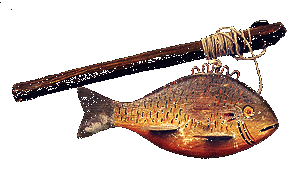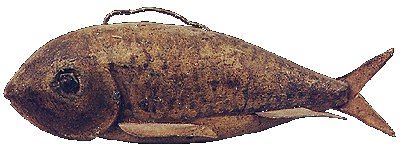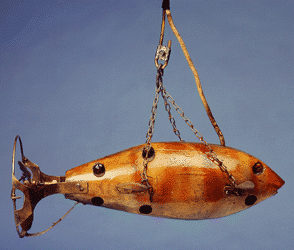|
Wisconsin
 Maker Unknown / Fish Decoy Carved, painted wood with attached metal fins, painted eyes and "jigging" stick. Length.4", c. 1900 |
|
The fine examples shown above and below, collected by J. Finn and now resident in his private collection, are good examples of the Wisconsin carved decoys from the turn of the last century. These examples come from the LaCrosse area, a particularily good area for the production of decoys. Fish decoys carved in the area in the early 1900's, are unique and highly sought after. Most of the local carvers made only a few decoys for their own personal use, so they were not produced in large quantities.
Maker
Unknown / Fish
Decoy This,
along with the high quality of the carving, attributes to their
scarceness and desirability to collectors. La Crosse fish decoys
are usually small in size, from 2 to 8 inches long, with the average
size of 5 inches.
Jigging sticks were used with most of the La Crosse area decoys. The fish decoys were worked around in a circle to give them a swimming action.
Maker
Unknown / Fish
Decoy Short-handled spears were used because the fishing shanties were usually small so they could be easily moved and heated. Spear fishing was outlawed by 1940 in the La Crosse area, bringing fish carving to an end. Very few "old-timers" are left to reminisce and tell their stories of fish spearing on the Mississippi River, but the old days will live on through the fishing artifacts that have been left behind for us to enjoy, appreciate, and collect.
Maker
Unknown / Electric
Fish Decoy |




